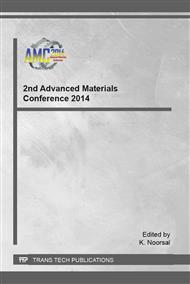p.3
p.8
p.13
p.18
p.23
p.28
p.33
p.38
The Effect of NiO Content on the Physical Properties of NiO–Samarium Doped Ceria Carbonate Composite Anode Powder for Solid Oxide Fuel Cells
Abstract:
The microstructure, specific surface area, and pore size distribution of nickel oxide–samarium doped ceria carbonate (NiO–SDCC) composite anodes were investigated with respect to wt.% NiO. Four types of composite anode powders were prepared by mechanically mixing NiO with SDCC electrolytes at different wt.% (50:50, 60:40, 70:30 and 80:20). XRD results demonstrated that the crystalline phase structure of NiO and SDCC does not show any phase change, but only exhibits the NiO and SDCC interface within the NiO–SDCC composite anode powder. SEM and BET results show that wt.% NiO considerably influenced the particle connectivity between NiO and SDCC, particle size, specific surface area, and pore size distribution. Specific surface area, and pore size increased whereas particle size decreased with an increase in wt.% NiO. The highest surface area (11.9 m2/g) and the largest pore volume (0.14 cm3/g) were obtained for NiO–SDCC (60:40) composite anode powder. Therefore, the composite anode with large specific surface area displays the highest catalytic activity and the lowest interfacial polarization resistance at the anode/electrolyte interface.
Info:
Periodical:
Pages:
18-22
Citation:
Online since:
January 2016
Authors:
Keywords:
Price:
Сopyright:
© 2016 Trans Tech Publications Ltd. All Rights Reserved
Share:
Citation:


